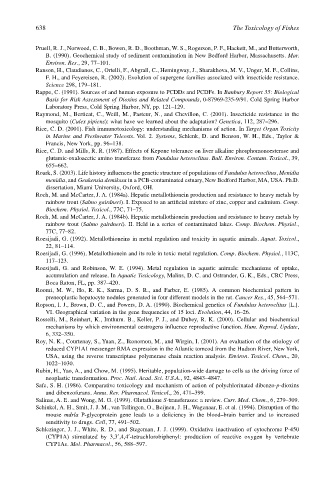Page 658 - The Toxicology of Fishes
P. 658
638 The Toxicology of Fishes
Pruell, R. J., Norwood, C. B., Bowen, R. D., Boothman, W. S., Rogerson, P. F., Hackett, M., and Butterworth,
B. (1990). Geochemical study of sediment contamination in New Bedford Harbor, Massachusetts. Mar.
Environ. Res., 29, 77–101.
Ranson, H., Claudianos, C., Ortelli, F., Abgrall, C., Hemingway, J., Sharakhova, M. V., Unger, M. F., Collins,
F. H., and Feyereisen, R. (2002). Evolution of supergene families associated with insecticide resistance.
Science 298, 179–181.
Rappe, C. (1991). Sources of and human exposure to PCDDs and PCDFs. In Banbury Report 35: Biological
Basis for Risk Assessment of Dioxins and Related Compounds, 0-87969-235-9/91. Cold Spring Harbor
Laboratory Press, Cold Spring Harbor, NY, pp. 121–129.
Raymond, M., Berticat, C., Weill, M., Pasteur, N., and Chevillon, C. (2001). Insecticide resistance in the
mosquito (Culex pipiens): what have we learned about the adaptation? Genetica, 112, 287–296.
Rice, C. D. (2001). Fish immunotoxicology: understanding mechanisms of action. In Target Organ Toxicity
in Marine and Freshwater Teleosts. Vol. 2. Systems, Schlenk, D. and Benson, W. H., Eds., Taylor &
Francis, New York, pp. 96–138.
Rice, C. D. and Mills, R. R. (1987). Effects of Kepone tolerance on liver alkaline phosphomonoesterase and
glutamic-oxaloacetic amino transferase from Fundulus heteroclitus. Bull. Environ. Contam. Toxicol., 39,
655–662.
Roark, S. (2003). Life history influences the genetic structure of populations of Fundulus heteroclitus, Menidia
menidia, and Geukensia demikssa in a PCB-contaminated estuary, New Bedford Harbor, MA, USA. Ph.D.
dissertation, Miami University, Oxford, OH.
Roch, M. and McCarter, J. A. (1984a). Hepatic metallothionein production and resistance to heavy metals by
rainbow trout (Salmo gairdneri). I. Exposed to an artificial mixture of zinc, copper and cadmium. Comp.
Biochem. Physiol. Toxicol., 77C, 71–75.
Roch, M. and McCarter, J. A. (1984b). Hepatic metallothionein production and resistance to heavy metals by
rainbow trout (Salmo gairdneri). II. Held in a series of contaminated lakes. Comp. Biochem. Physiol.,
77C, 77–82.
Roesijadi, G. (1992). Metallothioneins in metal regulation and toxicity in aquatic animals. Aquat. Toxicol.,
22, 81–114.
Roesijadi, G. (1996). Metallothionein and its role in toxic metal regulation. Comp. Biochem. Physiol., 113C,
117–123.
Roesijadi, G. and Robinson, W. E. (1994). Metal regulation in aquatic animals: mechanisms of uptake,
accumulation and release. In Aquatic Toxicology, Malins, D. C. and Ostrander, G. K., Eds., CRC Press,
Boca Raton, FL, pp. 387–420.
Roomi, M. W., Ho, R. K., Sarma, D. S. R., and Farber, E. (1985). A common biochemical pattern in
preneoplastic hepatocyte nodules generated in four different models in the rat. Cancer Res., 45, 564–571.
Ropson, I. J., Brown, D. C., and Powers, D. A. (1990). Biochemical genetics of Fundulus heteroclitus [L.].
VI. Geographical variation in the gene frequencies of 15 loci. Evolution, 44, 16–26.
Rosselli, M., Reinhart, K., Imthurn. B., Keller, P. J., and Dubey, R. K. (2000). Cellular and biochemical
mechanisms by which environmental oestrogens influence reproductive function. Hum. Reprod. Update,
6, 332–350.
Roy, N. K., Courtenay, S., Yuan, Z., Ikonomou, M., and Wirgin, I. (2001). An evaluation of the etiology of
reduced CYP1A1 messenger RMA expression in the Atlantic tomcod from the Hudson River, New York,
USA, using the reverse transcriptase polymerase chain reaction analysis. Environ. Toxicol. Chem., 20,
1022–1030.
Rubin, H., Yao, A., and Chow, M. (1995). Heritable, population-wide damage to cells as the driving force of
neoplastic transformation. Proc. Natl. Acad. Sci. U.S.A., 92, 4843–4847.
Safe, S. H. (1986). Comparative toxicology and mechanism of action of polychlorinated dibenzo-p-dioxins
and dibenzofurans. Annu. Rev. Pharmacol. Toxicol., 26, 471–399.
Salinas, A. E. and Wong, M. G. (1999). Glutathione S-transferases: a review. Curr. Med. Chem., 6, 279–309.
Schinkel, A. H., Smit, J. J. M., van Tellingen, O., Beijnen, J. H., Wagenaar, E. et al. (1994). Disruption of the
mouse mdrla P-glycoprotein gene leads to a deficiency in the blood–brain barrier and to increased
sensitivity to drugs. Cell, 77, 491–502.
Schlezinger, J. J., White, R. D., and Stegeman, J. J. (1999). Oxidative inactivation of cytochrome P-450
(CYP1A) stimulated by 3,3′,4,4′-tetrachlorobiphenyl: production of reactive oxygen by vertebrate
CYP1As. Mol. Pharmacol., 56, 588–597.

